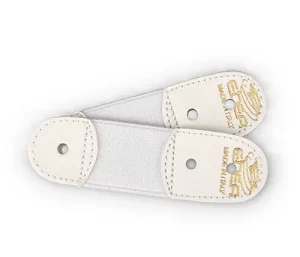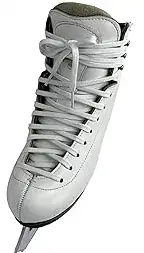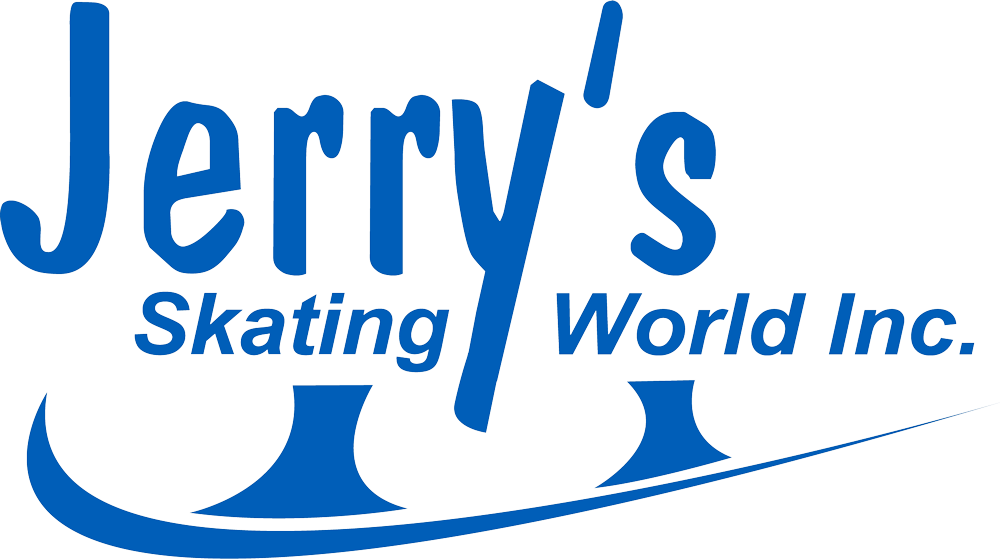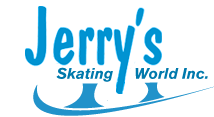Jerry's Tips & How-To Guides
Lacing Your Boots
There are many ways to lace your boots. Here are some great tips on doing it the right way..
Tighten Your Lace
Learn a little more about the science of proper lace tightening with these helpful insights..
Boot Care & Maintenance
Taking care of your boots is easy.. Here are some great tips on cleaning, storage and appearance..
Blade Care
The condition of your blades will effect your performance on the ice. Here are great tips from Jerry on blade care..
Lacing Your Boots
Mathematically there are about 2 trillion different ways to lace a boot with 6 eyelets.
We’ve researched this complicated area to save you the time.
This means you can lace the boots not only with the correct pattern but with the right tightness through the shoe to maximize your skating.
 Edea produce special skating laces that have extra strong fibers running though the length which helps to prevent loosening.
Edea produce special skating laces that have extra strong fibers running though the length which helps to prevent loosening. The addition of an Edea lace strap will also reduce slipping and allow the skater to tuck lace ends away for a more stylish look. However, even with extra strong laces and lace straps the constant strain on laces mean they need replacing.
The addition of an Edea lace strap will also reduce slipping and allow the skater to tuck lace ends away for a more stylish look. However, even with extra strong laces and lace straps the constant strain on laces mean they need replacing.At Edea we recommend replacing laces every 2/3 months depending on your training programme.
 EDEA TIP
EDEA TIP The Herringbone pattern is the most commonly used and is the one we recommend. This allows the boot to be held firmly and offers the flexibility to spread the tension as required throughout the length of the boot.
The Herringbone pattern is the most commonly used and is the one we recommend. This allows the boot to be held firmly and offers the flexibility to spread the tension as required throughout the length of the boot. The laces should be passed over the eyelets and threaded from the outside to the inside.
The laces should be passed over the eyelets and threaded from the outside to the inside. This allows the lace to be pulled horizontally and also offers 3 other main advantages
This allows the lace to be pulled horizontally and also offers 3 other main advantages· No direct pressure on the instep
· The lace can hold the foot firmly and evenly
· The laces are self locking at every phase, which helps stop them coming undone.
 At the ankle area where the hooks are we recommend laces are threaded from the inside over the hook, around the outside to the bottom and then up to the next hook.
At the ankle area where the hooks are we recommend laces are threaded from the inside over the hook, around the outside to the bottom and then up to the next hook.This will ensure:
· A uniform inward pressure on the hook – keeping the laces tighter
· The lace can self-lock on every hook and help prevent loosening
· Direct pressure is applied to the boot rather than the leg
· A ‘V’ shaped closure forms at the top allowing the ankle to bend more easily to maximise skater flexibility and performance.
 When taking the boot off loosen the laces ALL the WAY DOWN, so releasing tension off the boot to ensure it maintains its perfect fit.
When taking the boot off loosen the laces ALL the WAY DOWN, so releasing tension off the boot to ensure it maintains its perfect fit.Tip: Do not leave laced boots in a hot car, as they may loose shape.
 The human foot is not symmetrical, with the inner foot wider while the outer foot is smaller.
The human foot is not symmetrical, with the inner foot wider while the outer foot is smaller.The tongues job in a shoe is to protect the instep and allow the foot to bend. This action is even more crucial in a skate where this flexibility is the difference between winning and losing.
This means the tongue needs to be held firmly in place by secure lacing, without this it follows the a-symmetry of the foot and moves outwards effecting both performance and comfort.
This is another reason we recommend that you lace not only with the correct pattern but with the correct tightness.
However, even with the correct pattern and tension sometimes a misalignment in your foot arch can still cause the tongue to move around.
To help prevent this Edea has introduced a lace holder on its professional boots.
The lace holder forces the tongue to follow the direction of the laces rather than trying to fall outwards.
 1. Pull both the tips of the laces through the holder
1. Pull both the tips of the laces through the holder 2. Tongue Binding
2. Tongue BindingOn our ICE FLY boots a further binding is applied over the tongue to avoid it bending and hitting the top part of the toes during strenuous movements.
The tightened laces keep the tongue firmly attached to the upper to maximize performance.
Tighten Your Lace
 The heel area is the part of the foot that controls the skate and it is essential that the heel is kept in place during skating.
The heel area is the part of the foot that controls the skate and it is essential that the heel is kept in place during skating.
For this reason we recommend that rather than even tension throughout the lace that an ‘egg timer’ pattern is followed as this ensures correct foot position and maximum flexibility.
At the toe end of lacing the laces should be slightly looser to facilitate toe movement.
Laces should then be pulled tighter across the instep to keep the heel securely in place.
This will allow the laces to be looser across the ankle to allow the leg and foot to bend. The tighter the lacing here the harder it is to move as the resistance of the boot is determined by the laces. Our lacing method allows the laces to be looser here. Edea boots combined with the Edea lacing method gives the skater the best range of movement
Once the boot is laced properly you can check the tension by running your fingers over them, they shouldn’t move.
Lacing and unlacing can be made easier with an Edea lace puller.Edea boots are anatomically designed to work with the foot and thus allow the best lacing pattern for the most effective performance. There is no longer the old fashioned need to strangle the top of the foot to keep the skate in the right position which restricts both movement and performance.
 To help you get the right pattern and feel for your boot compare the two different lacing patterns.
To help you get the right pattern and feel for your boot compare the two different lacing patterns.Boot B (right side) is laced properly while Boot A (left side) is laced incorrectly.
If you follow Boot B you’ll get the maximum range of movement, enhanced performance and the boot will last longer.
If your lace pattern is more like boot A you’ll be hindering your performance.
Check your lacing patterns against boot B to achieve the correct tightness and see how the feel, the comfort and your skating improves.
When taking the boot off loosen the laces ALL the WAY DOWN, so releasing tension off the boot to ensure it maintains its perfect fit.

Tip: Do not leave laced boots in a hot car, as they may loose shape.
Boots - Care & Maintenance
Taking care of your boots is really simple and will make them last longer.
Putting on a gleaming pair of Edea skates that have been looked after will make you feel great and boost your performance.
Just follow our simple tips for better boots and perfect skating. If you look after them, they’ll look after you.
 After every session always wipe and dry the blades to stop them rusting.
After every session always wipe and dry the blades to stop them rusting. Remove dust and moisture from boots by using a microfiber or cotton cloth.
Remove dust and moisture from boots by using a microfiber or cotton cloth. Clean the boot with water and unscented soap.
Clean the boot with water and unscented soap.As the boots are waterproof this won’t damage your boots but it will make them sparkle.
 To cover scratches, simply use Edea polish.
To cover scratches, simply use Edea polish. When you are back from the rink dry the boots in the open air.
When you are back from the rink dry the boots in the open air.If you can’t do this or you’re in a hurry (or on tour) use our odor absorbers. They are designed not only to absorb unpleasant odors but also to absorb moisture.
 The tongue should be placed in an upright position when the boots are not in use.
The tongue should be placed in an upright position when the boots are not in use.The tongue is designed to take on the shape which is impressed on it.
If you leave it distorted you will find it distorted the next time you put your boots on.
 Loosen the laces to take off the boot, and loosen them further when not wearing the boots.
Loosen the laces to take off the boot, and loosen them further when not wearing the boots.If not the instant shaping feature designed to give the best fit will shrink the boots as they cools down from 37 °C.
 Change your laces every 2/3 months.
Change your laces every 2/3 months.This allows better lacing and is a cheap way to provide comfort and added safety to your boot.
 Change your socks every session.
Change your socks every session.Performing will mean sweat and this means bacteria which can cause unpleasant odors and allergies.
 Change your insoles regularly, they tend to warp with overuse – which apart from defeating the purpose of inner soles can mean bacteria build up and unpleasant odors.
Change your insoles regularly, they tend to warp with overuse – which apart from defeating the purpose of inner soles can mean bacteria build up and unpleasant odors. Check the structure and integrity of the boot to ensure it is performing; this will avoid issues at competition time.
Check the structure and integrity of the boot to ensure it is performing; this will avoid issues at competition time.Check the mounting screws are tight and that they are holding the blade for safety reason.
Blade Care
The condition of your blades will effect your performance on the ice. Keep the edges in great condition and be responsible for your blade care when you’re off the ice.
Here are 5 tips to keep your blades in top condition:
- Keep your ice skate blades sharp but not too sharp. A sharp blade grabs the ice better than a dull one. Make sure you sharpen your ice skates appropriately for their type. Hockey skates can be sharpened on an automatic machine. But figure skates require a professional sharpener to give them the correct “edge”.
- Don’t walk on the ground or floor with your ice skate blades. Instead, always use a skate guard when you are off the ice. If you absolutely can’t wear guards, walk on the toe picks instead of the delicate edges.
- Always dry ice skate blades thoroughly after skating. Rust is the biggest killer of blades and the mounting area. Each time, before you slip on your skate guards, slide your fingers (carefully) along both sides of the blade to remove the “snow.” When you’re done for the day, take your skates off and dry them with a towel. Be sure to dry the blades and the mounting surfaces. If you have time, it is a good idea to let them sit for a couple minutes and then wipe them down again.
- After drying skates thoroughly, cover and store the blades inside of towel-like soakers. These help draw off any remaining moisture and provide a cushion for your blades inside your bag. Do not leave or store blades inside of plastic or rubber skate guards. They hold moisture and almost guarantee rust.
- Keep your skate guards clean. Wipe out the insides of your guards so no grit or grime builds up over time. If your guards or soakers wear out (get thin spots or holes in the bottom) replace them immediately. They won’t help you protect your blades if they are run down or broken.


